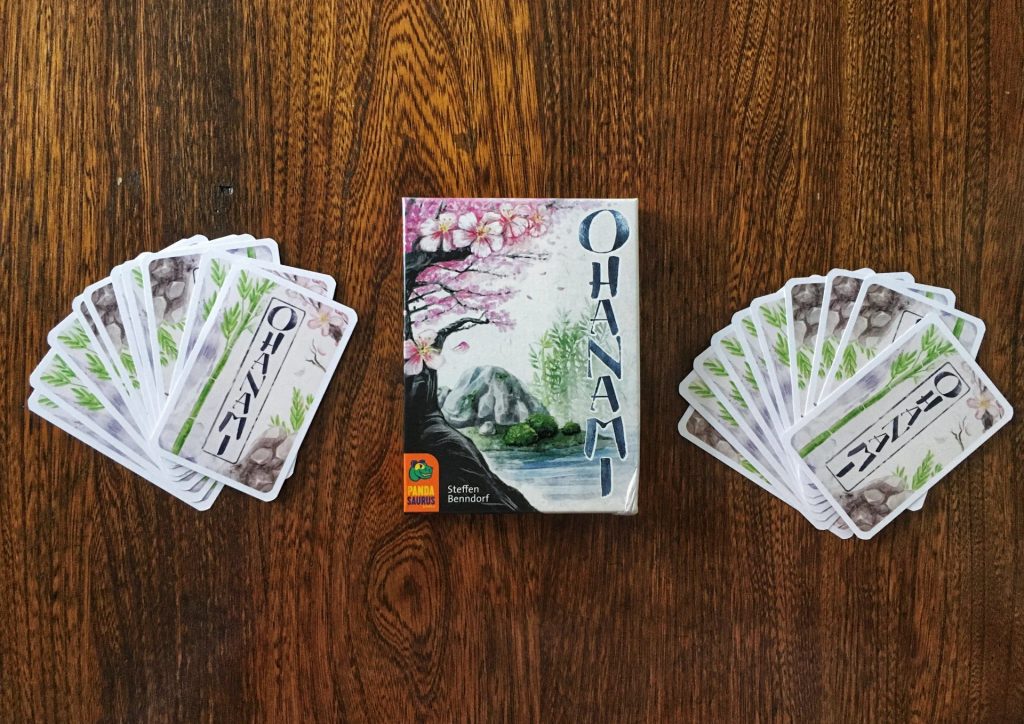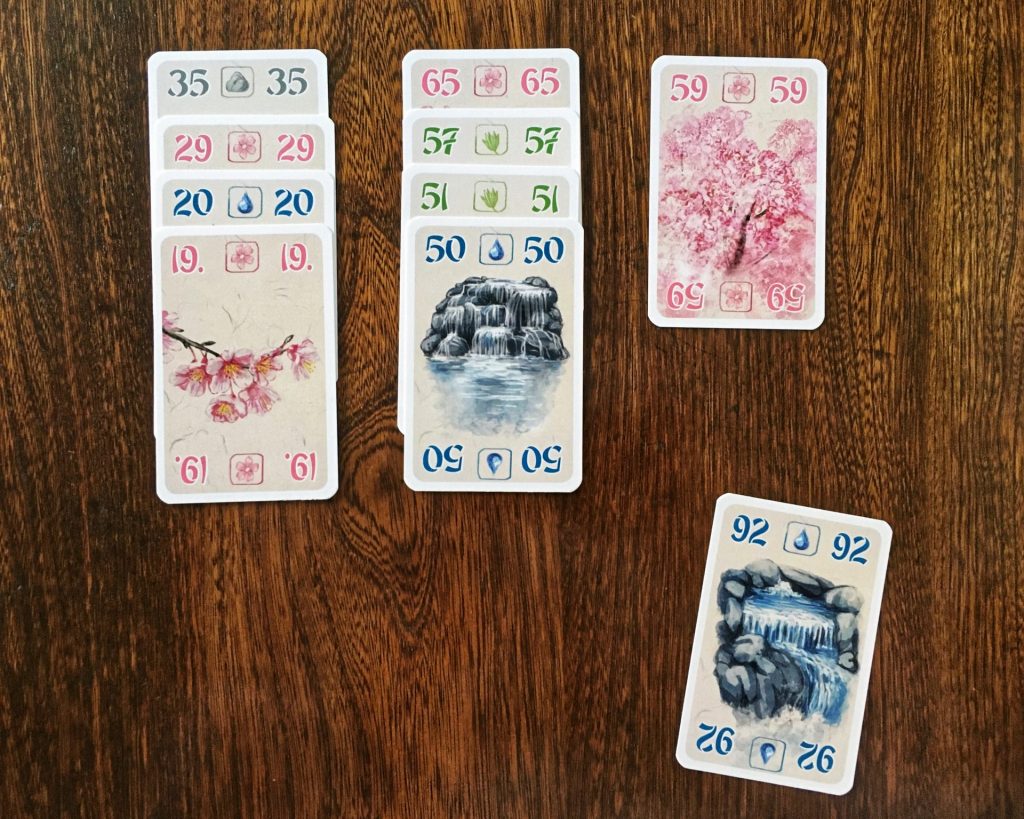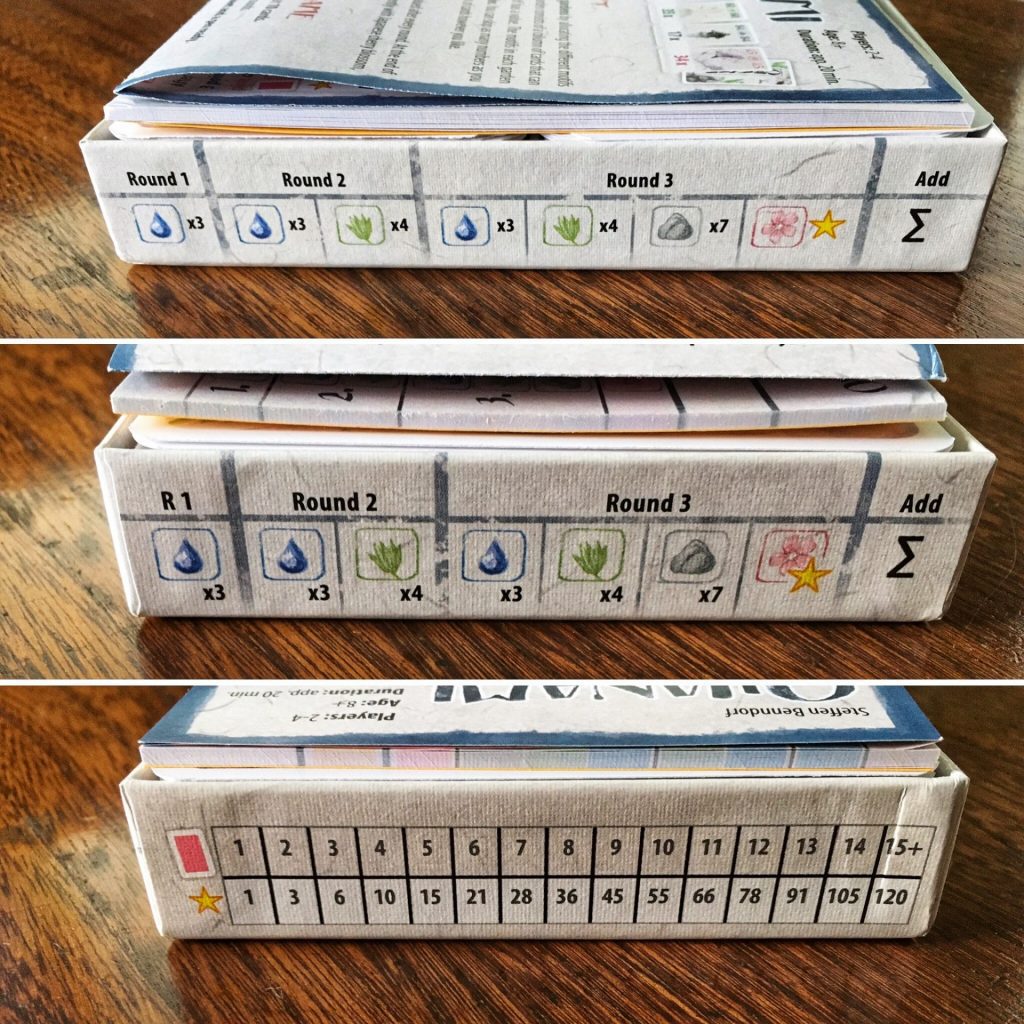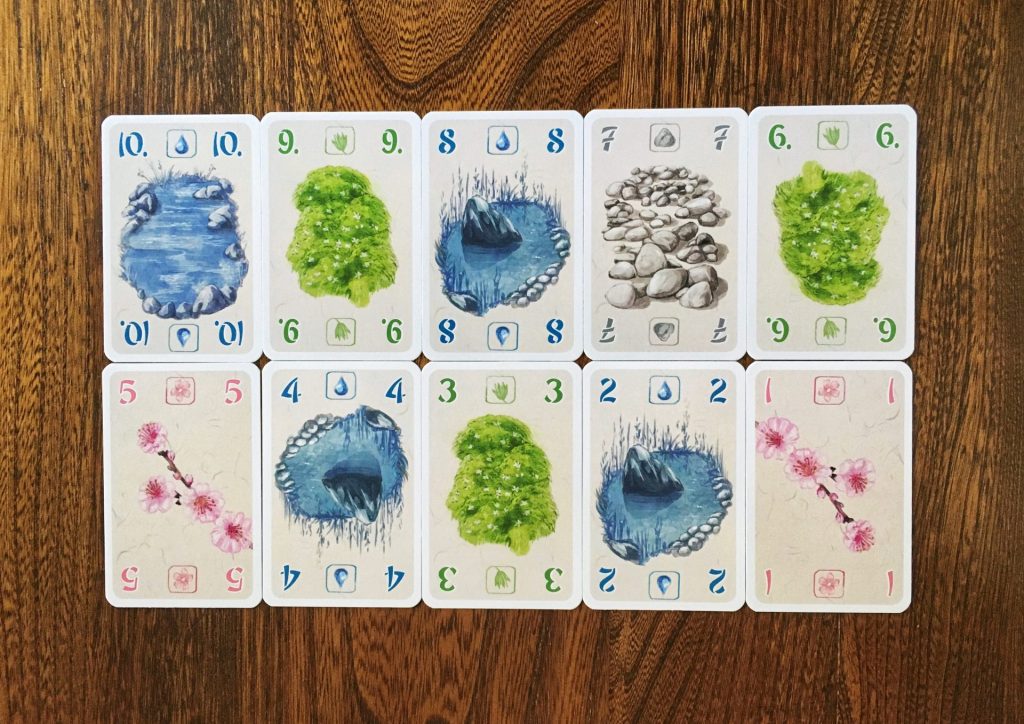Disclosure: Meeple Mountain received a free copy of this product in exchange for an honest, unbiased review. This review is not intended to be an endorsement.
Ordered gardens bloom
Blossom flutters in the draft
Water’s hidden worth
– Haiku by Meeple Mountain’s own Andrew Holmes*
Hanami (or ‘flower viewing’) is the traditional Japanese “custom of enjoying the transient beauty of flowers” (‘hana’). In most cases the flowers refer to those of the cherry blossom (‘sakura’). This custom involves more than simply looking at the flowers; hanami is celebrated by having an outdoor party beneath the blossoming trees, marking the beginning of spring. Because hanami is so important, an ‘o’ is often added before ‘hanami’ as a sign of politeness and respect.
Ohanami is a game for two to four players in which each player works to grow up to three personal gardens through card drafting. Each garden is represented by a column and a player may only add cards to a column on either end of it (the top or the bottom). Cards in a column must always be in numerical order so the number on a card determines where it could be placed. The colour of a card determines how the card scores at the end of the round.
Flower, Bird, Wind, Moon – How to Play Ohanami
To begin a game of Ohanami, each player is dealt a hand of ten cards.

Since Ohanami is a card drafting game, there are no player turns; each player chooses two cards from their hand and places them facedown in front of them. They then pass the remaining cards in their hand to the next player. Over the game’s three rounds, the direction of drafting switches between clockwise and counterclockwise.
Once all players have chosen their cards, players reveal their two selected facedown cards and decide what to do with each: use them or discard them. Players can choose to use both cards, discard both, or use one card and discard the other.
Discarding a card is simple: the card is just placed in a facedown discard pile with no reward gained. Using a card, on the other hand, is where the game’s puzzley gameplay shines through.
Flowers Are Often Scattered By The Wind
Each player can have up to three gardens (read: columns of cards) in front of them during a game of Ohanami. To use a card, the player may start a new garden with it or add it to an existing garden. The kicker is that once a card is in place, it remains there for the entire game.

Any card — regardless of its colour or value — may be used to start a new garden. However, for a player to add a card to an existing garden, the card must either be of a higher value than the garden’s highest card or of a lower value than the garden’s lowest card. This means that the cards in each garden must be in numerical order. Although gaps between card values are permitted, you want to avoid having too much of a gap between the cards you add to a single garden because the bigger the gap, the more limited your options become.

After each player has used or discarded their two selected cards, they pick up the hand of cards that was passed to them and repeat the drafting process. The round ends when all cards have been drafted and players then proceed to an end-of-round scoring.
Dumplings Over Flowers – End-of-Round Scoring
At the end of round 1, players score 3 points for each blue card (with the water droplet motif) in all of their gardens.

After scoring for the round, all cards in front of players remain in their gardens. Then ten more cards are dealt to each player and a new round begins with players repeating the same drafting process.
At the end of round 2, players score 3 points for each blue card and 4 points for each green card (with the grass motif) in all of their gardens.

At the end of round 3 (which also signals the end of the game), players score 3 points for each blue card and 4 points for each green card. They also score 7 points for each gray (stone) card and points for their pink (flower) cards — depending on the total number of pink cards they have added to their gardens throughout the game. The player with the most points after three rounds wins.

Final Thoughts
Small box card games make up about 25% of my board game collection — and that jumps to just over 40% if you count strictly card-based games in bigger boxes with a few components like cardboard tokens or a board (games like 7 Wonders and Lost Cities, for instance). I knew I liked little card games quite a lot, but even these numbers surprised me.
I think this card-based love can be traced back to my earliest game experiences; I have vivid memories of my uncle teaching my young self how to play Bloody Knuckles…and then playing the heck out of it with him. (After an extensive search on the web, I could not, for the life of me, find a link to rules for this card game.) I feel this early love for card games has only blossomed (pun intended) the more invested in the hobby I become. I can now really appreciate the creativity and genius that goes into designing a game and its mechanisms around a deck of cards.
Ohanami is a great example of this. It’s a game that consists of 120 cards that players lay out in numerical order in one of three columns in front of them. The mechanisms and ruleset couldn’t be more simple, yet the gameplay is so deep and filled with tough choices. When selecting your two cards, you must consider so much: the value of the cards and how they can help or hinder your gameplay, where and in which garden to place them, and the colours of the cards and where you want to focus your strategy. Not to mention, since this is a drafting game, you are always considering what your opponents can benefit from in your hand of cards — and how you might need to denial-draft and discard cards.

One thing I really appreciate about Ohanami is how the four different colours of cards are distributed. For instance, cards from 1 to 10 aren’t only one colour, but have a variety of all four colours. This lends itself to there being many paths to victory because a player focusing on the pink cards, for example, won’t necessarily also be collecting a specific range of numbers. Conversely, one person collecting a sequence of numbers won’t skyrocket to victory because they happened to get lucky with a hand filled with one colour of card.

Not surprisingly, I think Ohanami is a great small box game with big gameplay. Of course it has a new home in my collection and you should consider adding it to yours too if you like thinky, card drafting games.
Thematic Music for Playing Ohanami
I haven’t yet had a chance to experience ohanami in Japan for myself and in my research I’ve found conflicting information about whether or not music can be played in the public outdoor celebration of this custom. (Some sources have reported that in the past this was acceptable, while others say it no longer is and is actually considered rude to do so.) As such, I’m inclined to recommend playing Ohanami without any music so players can admire the card gardens they create without any aural distractions.
*A big thank you to Andrew Holmes for his beautiful (and appropriate) Ohanami haiku. To read more board game haiku from Andrew, check out Board Game Haiku: Tabletop Games in Seventeen Syllables, A Hat Hits the Ground: More Board Game Haiku, and The Island Awaits: Board Game Haiku Volume 3.












I am trying to enter this contest. However, after each of the items, I am told I need to re-log-in to the Gleam account. I do, and then I have to request a new confirmation code. I request it, enter it, and then it tells me that I have no entries into this contest…
Thus far I have:
* Tweeted
* Followed @meeplemountain
* Followed @pandasaurusgame
* Visited the Meeple Mountain channel on YouTube
* Visited the Meeple Mountain page on Facebook
* Visited the Pandasaurus Games page on Facebook
* Visited Ohanami’s homepage
* Clicked on the Daily Bonus
I have, at times, seen 4, 5, or 6 entries listed… then when it forces me to log in again, those go away.
Is there something I need to do to clear this up?
Hey David, it could be an issue with ad blocker software? Gleam has an FAQ that might offer some suggestions on how to get it working:
https://gleam.io/docs/faq/contestant
Alternately you could try entering on this dedicated page:
https://gleam.io/N8v0B/ohanami-giveaway-from-pandasaurus-meeple-mountain
OK. I turned off my ad blocker for this site (per our earlier email conversation). This has not helped in this regard.
I went through the FAQ you linked. I have the Infinite Login Loop issue they describe, but the proposed actions are not helping here.
I attempted to use the dedicated page you linked. It has the same issue.
All of that said, the page currently shows I have 7 entries (I am missing the two follow on twitter items, which it will not let me complete).
I think I will stick with these seven for now, and see if I can get this updated later when I attempt the next Daily Bonus entry. 🙂
I think I have this figured out and corrected.
Thanks for the help, and as always: keep doing all that you do! Much appreciated.